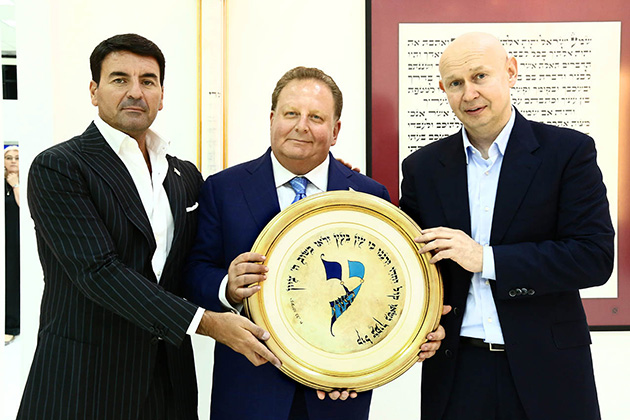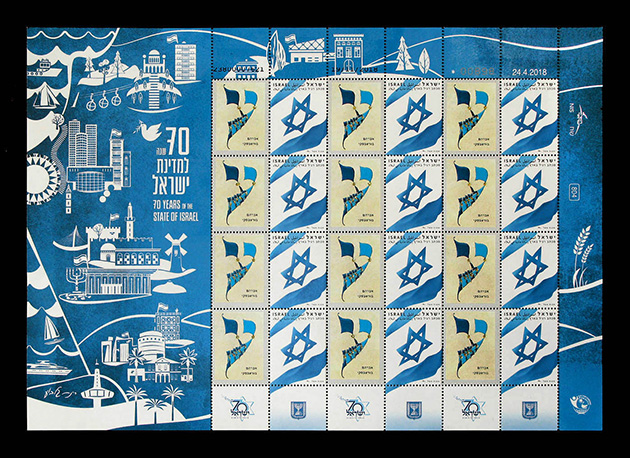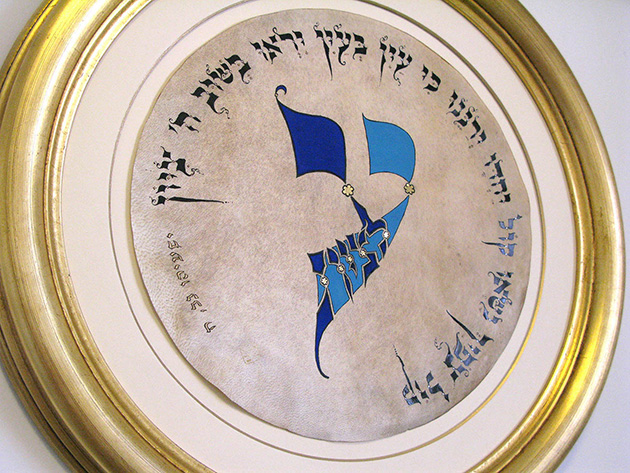A Miniature Sheet With “Israel’s 70” Calligram of Avraham Borshevsky

One of the most valuable and insightful works that have joined our Museum’s collection this year is Avraham Borshevsky’s calligraphic masterpiece "Ayin Le’Tziyon”, or “ISRAEL’S 70”, a generous gift of internationally renowned businessmen Mr. Giuseppe Aquila (Italy) and Mr. David Veitsman (USA) for the Museum’s 10th anniversary.
At the end of 2018 Borshevsky’s creation was also reproduced in a philately form - the Israeli Postal Service printed a limited edition miniature sheet set “70 years of the State of Israel” of 12 stamps with the calligram on the coupon.

Inspired by the State of Israel’s 70 years of independence, also celebrated in 2018, one of the exhibitors of our Museum, Israeli artist Avraham Borshevsky created the parchment during his work on the unique Writing Instrument Box set manufactured by leading Italian brand Montegrappa.

Centered in a round eye-like parchment with a golden frame is Hebrew calligram “Ayin Le’Tziyon”. Painted in vibrant shades of blue, it is shaped as the Hebrew letter “Ayin”. Identical to the name of the letter, Hebrew word "ayin" means “an eye”. The artistic concept behind the calligram is based on this word-play and the Gematria* numeric values that are commonly known among Israelis.
Ayin’s numerical value in the Hebrew alphabet is 70, where as the word Zion** has been synonymous to “Israel” since ancient days. Israel’s national anthem, called “HaTikva”, or “the Hope” says: “Ayin Le’Tziyon tzofiyah”, which means literally "an eye still gazes toward Zion". Therefore the first two words of the line - "Ayin Le’Tziyon” — can be read as “70 [years] to Israel”.
This line from Israel’s national anthem echoes the verse from a biblical prophecy by Isaiah about future redemption: “The voice of your watchmen is heard: they lift up the voice; together shall they sing: for they shall see for eye to eye, God returning to Zion.”(Isaiah 52:8)
The parallel between an ancient prophesy and the anthem of the re-built Jewish state underlines an intrinsic connection between the return of the Jewish people to their Promissed Land and the return of God’s “visibly felt” presence to Israel.
Borshevsky’s powerful graphic image that looks as a stylish modern logo, hides yet another surprise. The numeric value (Gematria) of the two words “Ayin Le’Tziyon" in Hebrew equals to 316. Read from right to left, as Hebrew text, it becomes 613 — the exact number of all the commandments given by the Torah to the Jewish people, many of which can only be completed in the holy land of Israel.
The fusion of the concepts of “traditional” and “cutting edge” in modern Israeli culture is expressed in the calligram through Borshevsky’s use of the ultramarine egg tempera, often found in ancient parchment manuscripts on the left side of the calligram, and the turquoise synthetic acrylic on the right. The sides are united by seven golden flowers that symbolize the Menorah - the golden chandelier in the Jerusalem Temple, and the seven decades of Israel’s independence. The biblical quote that circumvents the calligram is completed in Turkey quill and Torah scribe’s black ink with silver foil pressing.
*Gematria – the Kabbalistic method of Numerology. The use of such “word math” for symbolic imagery in text interpretation plays a substantial role in Avraham Borshevsky’s work.
**Zion/Tziyon — the root of the concept of Zionism — the national liberation movement for Jewish sovereignty in the land of Israel.